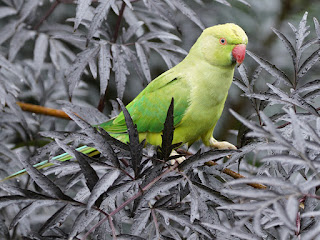It rained and drizzled for most of an unseasonably cold day. This didn't deter the Hobbies, who were wheeling around between the trees in the plane avenue. Here are two young ones in different trees.
At one moment I saw five in the air, which was surprising as only two young have been reported. Possibly they were having a fight with the local Kestrel. They were just black dots against the sky, with no colour visible.
The female Little Owl at the Round Pond had retreated right to the back of her hole and you could only see the top of her head.
A damp Wood Pigeon in a Portuguese laurel couldn't reach any of the ripe berries, which grow on the tips of thin twigs. It could reach some unripe ones but avoided them. Normally Wood Pigeons will eat any fruit no matter how unripe, but this is a poisonous species containing hydrogen cyanide especially in the unripe fruit, and perhaps the extremely bitter taste warned it off.
A Rose-Ringed Parakeet looked out of place in a cowbane bush in the Flower Walk. This species, Cicuta virosa, is also called water hemlock and is a member of the same family as ordinary hemlock and hemlock water dropwort. All of them are extremely toxic and gardeners are supposed to wear gloves when handling this one.
Farther along the Flower Walk a Robin looked over a wet leaf. This isn't the familiar Robin, who is looking a bit tatty at the moment, but it came to my hand anyway and took several pine nuts.
The usual Great Tit in the Rose Garden, also expecting a treat, waited among rose hips.
A large flock of Long-Tailed Tits and other small birds, mostly Blue Tits, swept along the edge of the Long Water.
One of the Grey Heron chicks on the island could be seen on the nest, looking depressed in the rain.
A young heron was attracted by the remains of one of Pigeon Eater's victims but couldn't swallow it whole and was obliged to leave it.
Three of the four Great Crested Grebe chicks on the Long Water could be seen under the poplar.
The family on the Serpentine were out in the middle, too far off to photograph in bad light.
The Coot nesting in the Italian Garden was harassed by a Black-Headed Gull, though this was too small to cause harm and was just being annoying.
In this picture you can see two eggs in the water, probably deliberately thrown out by the Coot. They can detect infertile eggs, most likely by listening for a tiny heartbeat, and then eject them. But this leaves only three eggs in the nest.
The Coot below the parapet in the Long Water was sitting tight on the nest and I couldn't see if there were any more eggs today. But the nest has got considerably larger: reed nests can be built up quickly.
A young Moorhen picked at a plant on the edge of the Serpentine.
Two Mute Swans ate the leaves in a reed bed. These are very tough and fibrous, but swans have serrated bills and can grind their way through most things.
A family of Egyptian Geese arrived at the Henry Moore sculpture and gave one of the resident Carrion Crows its marching orders.
The rain spoilt an attempt by some absolutely normal young people to have a picnic, so they moved to the Italian Garden loggia.















I only dress like that on weekends too
ReplyDeleteMy usual weekend attire.
DeleteIf that's your idea of absolutely normal, I would hate to think what you would consider weird !!....
ReplyDeleteWell, I consider this to be slightly unusual, at least on a weekday.
DeleteO tempora, o morons. As they say.
ReplyDeleteIt's amazing that Coots should be able to detect the chick's heartbeats. I know some bird species will call to the chicks to encourage them when they're about to hatch, and the chick will peep back still inside the shell. It's just amazing.
Tinúviel
Well, I suppose that's how the Coot detects life in the egg. There really is no other way. It must take a few days before anything is audible, of course.
Delete